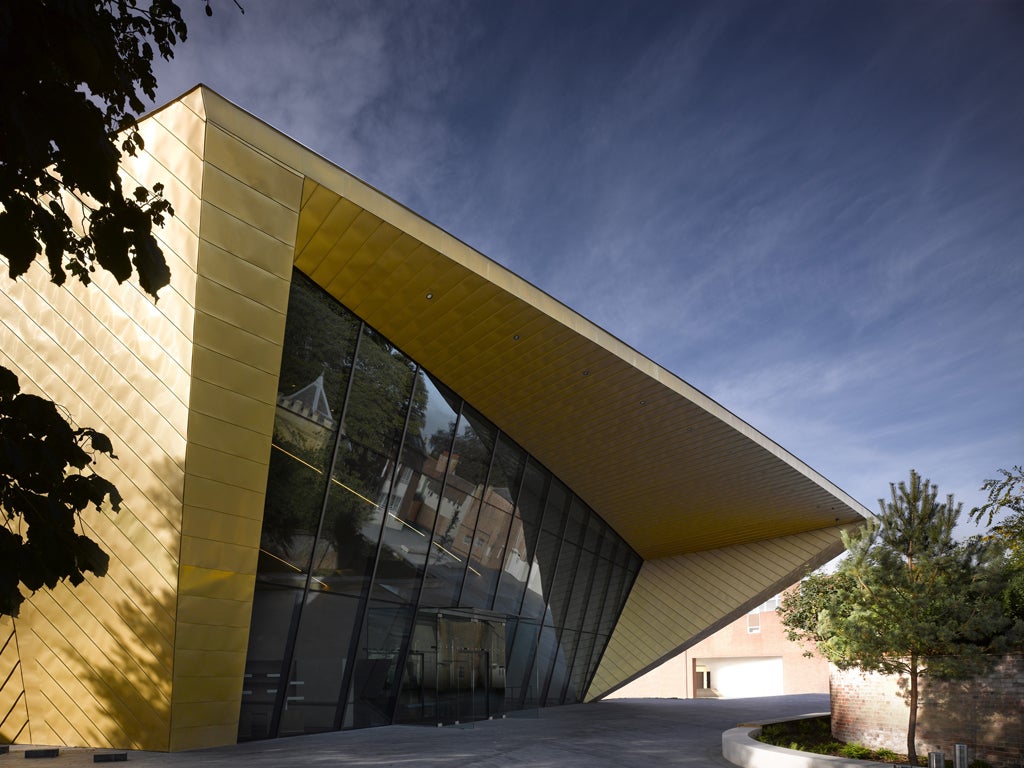Camulodunum, Firstsite, Colchester
A modern art gallery is a welcome addition to Britain's oldest town, but its first show is timid

Some time in the past 10 years, the director of the Institute of Contemporary Arts was interviewing for a curator's job.
One applicant came from a gallery in a small town in Germany. How many visitors did her venue have? Five thousand, came the cheery reply. A week or a month, pressed the director. There was a pause. Then, with a puzzled smile, the would-be curator said, "A year, I mean."
The British are latecomers to the idea of contemporary art as an essential part of civic life. Few German towns of more than a few thousand will not have some kind of modern gallery or Stiftung, subsidised by local taxes. A town the size of Colchester – population 175,000, and due to pass 200,000 in the next few years – would have several. Yet England's oldest town has had just one modern gallery, and that a small affair in a Tudor house, run by the local art school. Now, after a predictable three-year delay with funding, it has another: Firstsite, by the Uruguayan architect, Rafael Viñoly.
Viñoly is a fine designer, adept at making intimacy grand and grandeur intimate. His Colchester gallery is no exception. Clad in warped copper sheeting, Firstsite has the air of a peculiarly elegant tramp steamer that has somehow run aground off Colchester High Street. Inside, the feel is of Eero Saarinen's TWA terminal, and none the worse for that – lofty, curved white spaces that welcome visitors without patronising them.
The question is what to put inside. This week, the schools commissioner identified coastal or estuary towns such as Colchester – largely monocultural, with a history of entrenched unemployment – as the most socially deprived in Britain. Firstsite is a local addition in the way that the Turner Contemporary is to Margate.
Like the Turner – and unlike, say, Tate St Ives – Firstsite does not have a permanent collection. That can be liberating. A collection imposes the duty of showing it, especially when – my heart sinks as I write the words – it is of local interest. For years, Tate St Ives showed St Ives art, much of it good, some of it of national (even international) importance. In the end, though, the gallery's local-first policy made the St Ives School seem parochial, which was hardly the point. It took a leap of faith on the part of the last director to turn the Cornish Tate into a first-class modern and contemporary gallery.
Which is to say that a gallery like Firstsite will have several, possibly conflicting, calls on its time. It will need to foster a sense of civic pride, but it will also need to offer its audience something more than localism. Last, for future funding purposes, Firstsite will have to put bums on seats. Five thousand visitors a year may play well in Essen, but it is not going to cut the mustard in Essex.
Colchester's city fathers hope that their new gallery, affectionately dubbed "the Golden Banana", will attract a hundred times that number. Alas, I doubt that the first exhibition will hasten them on their way. Called Camulodunum, the Roman name for Colchester, it bears all the signs of trying to do everything at once.
Unlike St Ives, there was at least no Colchester School to deal with. There is the grandeur that was Rome, however, and this, in the form of a case of Roman pottery, marks the show's starting point. To prove that contemporary art is not scary, this vitrine sits near another work, called Journey into the Heart of the Night, by the clay-fingered neo-Britartist, Rebecca Warren. AD200 and AD2000: it's all art, right? And somehow, unexpectedly, all Colchester.
From here you can follow the local trail to Grayson Perry (a Chelmsfordian rather than a Colchestrian, but at least from the right county), whose ceramic God is Sex sits in another glass box. This takes us either to photographs of The Neo-Naturists, a group of 1980s performance artists, of which the young Perry was one, or, via materials, to the Urbis Paganus photo-collages of the American artist, Richard Hawkins. From here you can double back to Sarah Lucas – clay again – or to Edwardian photographs of the Colchester Pageant. And then ... well, take your pick: Henry Moore (Roman-looking helmet), Barbara Hepworth (seaside holidays in Norfolk, almost Essex), Robert Smithson (I'm not sure: archaeology, maybe?), Bill Woodrow (don't know), etc. For what it's worth, I'm with the Germans in believing that every town should have a modern gallery, and I very much hope that this one works. It's beautiful, and it's necessary. But it will need to be brave, too, and Camulodunum isn't, or not enough.
Next Week:
Charles Darwent visits Grayson Perry's Tomb of the Unknown Craftsman at the British Museum
Art Choice
Stick your head in the clouds and make an effort to catch Tate Liverpool's René Magritte exhibition The Pleasure Principle before it closes on 16 Oct. In London, the V&A tackles that shiny, slippery Postmodernism with an eclectic collection of art, architecture, fashion and pop culture. Enjoy its Style and Subversion (till 15 Jan 2012).
Join our commenting forum
Join thought-provoking conversations, follow other Independent readers and see their replies
Comments